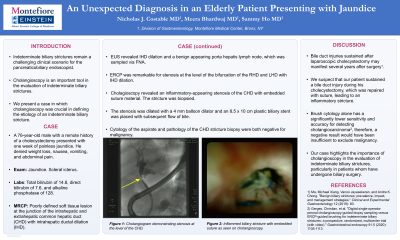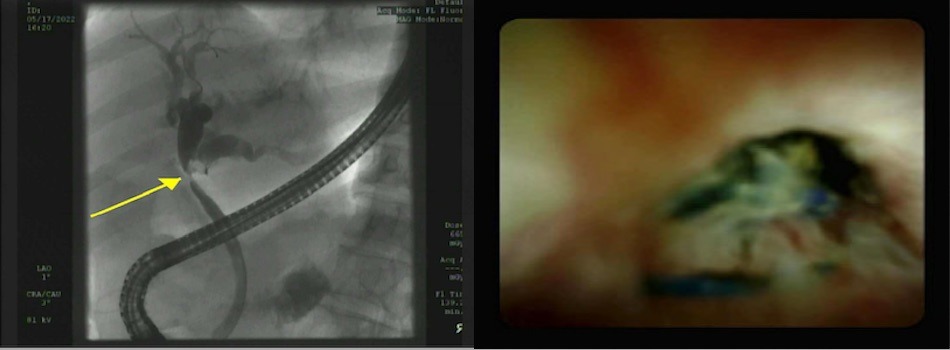Back


Poster Session A - Sunday Afternoon
Category: Biliary/Pancreas
A0030 - An Unexpected Diagnosis in an Elderly Patient Presenting With Jaundice
Sunday, October 23, 2022
5:00 PM – 7:00 PM ET
Location: Crown Ballroom

Has Audio

Nicholas J. Costable, MD
Montefiore Medical Center
Bronx, NY
Presenting Author(s)
Nicholas Costable, MD, Meera Bhardwaj, MD, Sammy Ho, MD
Montefiore Medical Center, Bronx, NY
Introduction: Cholangioscopy is an important tool in the evaluation of indeterminate biliary strictures allowing for direct visualization of strictures and targeted biopsies. We present an unusual case of painless jaundice where cholangioscopy played a crucial role in making the diagnosis.
Case Description/Methods: A 76-year-old male with a past medical history of hypertension and diabetes mellitus, and a past surgical history of a laparoscopic cholecystectomy ten years prior to presentation was referred for one week of painless jaundice, darkening of urine, and pruritus. He denied any weight loss, abdominal pain, nausea, or vomiting.
Laboratory evaluation was significant for a total bilirubin of 14.8, direct bilirubin of 7.6, AST 40, ALT 56, and alkaline phosphatase of 128. Magnetic resonance cholangiopancreatography was obtained, which revealed a poorly defined soft tissue lesion at the junction of the intrahepatic and extrahepatic common hepatic duct (CHD) with intrahepatic ductal dilation (IHD). Multiple small filling defects within the dilated ducts were also noted, suggestive of choleliths. The patient was referred for endoscopic ultrasound (EUS) and endoscopic retrograde cholangiopancreatography (ERCP).
EUS revealed IHD and a benign appearing porta hepatis lymph node with no endosonographic evidence of pancreatic mass or cysts. The lymph node at the porta hepatis was sampled using fine needle aspiration (FNA). ERCP was then performed, revealing a single stenosis at the level of the CHD with IHD. Cholagioscopy was performed, which revealed an inflammatory-appearing stenosis of the CHD with embedded suture material and a cholelith proximal to the stenosis. The stenosis was biopsied and dilated with a 4 mm balloon dilator. An 8.5 x 10 cm plastic biliary stent was placed with subsequent flow of bile. FNA cytology and pathology of the CHD stricture were both negative for malignancy.
Discussion: Our patient likely sustained a bile duct injury during his prior cholecystectomy, which was repaired with suture, leading to an inflammatory stricture and obstructive jaundice. We had a high suspicion pre-procedure for malignancy given this patient’s presentation, and as such cholangioscopy was crucial in determining the etiology of this patient’s stricture. Our case highlights the importance of cholangioscopy in the evaluation of indeterminate biliary strictures, particularly in patients whom have undergone biliary surgery.

Disclosures:
Nicholas Costable, MD, Meera Bhardwaj, MD, Sammy Ho, MD. A0030 - An Unexpected Diagnosis in an Elderly Patient Presenting With Jaundice, ACG 2022 Annual Scientific Meeting Abstracts. Charlotte, NC: American College of Gastroenterology.
Montefiore Medical Center, Bronx, NY
Introduction: Cholangioscopy is an important tool in the evaluation of indeterminate biliary strictures allowing for direct visualization of strictures and targeted biopsies. We present an unusual case of painless jaundice where cholangioscopy played a crucial role in making the diagnosis.
Case Description/Methods: A 76-year-old male with a past medical history of hypertension and diabetes mellitus, and a past surgical history of a laparoscopic cholecystectomy ten years prior to presentation was referred for one week of painless jaundice, darkening of urine, and pruritus. He denied any weight loss, abdominal pain, nausea, or vomiting.
Laboratory evaluation was significant for a total bilirubin of 14.8, direct bilirubin of 7.6, AST 40, ALT 56, and alkaline phosphatase of 128. Magnetic resonance cholangiopancreatography was obtained, which revealed a poorly defined soft tissue lesion at the junction of the intrahepatic and extrahepatic common hepatic duct (CHD) with intrahepatic ductal dilation (IHD). Multiple small filling defects within the dilated ducts were also noted, suggestive of choleliths. The patient was referred for endoscopic ultrasound (EUS) and endoscopic retrograde cholangiopancreatography (ERCP).
EUS revealed IHD and a benign appearing porta hepatis lymph node with no endosonographic evidence of pancreatic mass or cysts. The lymph node at the porta hepatis was sampled using fine needle aspiration (FNA). ERCP was then performed, revealing a single stenosis at the level of the CHD with IHD. Cholagioscopy was performed, which revealed an inflammatory-appearing stenosis of the CHD with embedded suture material and a cholelith proximal to the stenosis. The stenosis was biopsied and dilated with a 4 mm balloon dilator. An 8.5 x 10 cm plastic biliary stent was placed with subsequent flow of bile. FNA cytology and pathology of the CHD stricture were both negative for malignancy.
Discussion: Our patient likely sustained a bile duct injury during his prior cholecystectomy, which was repaired with suture, leading to an inflammatory stricture and obstructive jaundice. We had a high suspicion pre-procedure for malignancy given this patient’s presentation, and as such cholangioscopy was crucial in determining the etiology of this patient’s stricture. Our case highlights the importance of cholangioscopy in the evaluation of indeterminate biliary strictures, particularly in patients whom have undergone biliary surgery.

Figure: Figure A: Cholangiogram revealing hilar stricture. Figure B: Cholangioscopy revealing inflammatory stricture with embedded suture material.
Disclosures:
Nicholas Costable indicated no relevant financial relationships.
Meera Bhardwaj indicated no relevant financial relationships.
Sammy Ho indicated no relevant financial relationships.
Nicholas Costable, MD, Meera Bhardwaj, MD, Sammy Ho, MD. A0030 - An Unexpected Diagnosis in an Elderly Patient Presenting With Jaundice, ACG 2022 Annual Scientific Meeting Abstracts. Charlotte, NC: American College of Gastroenterology.
